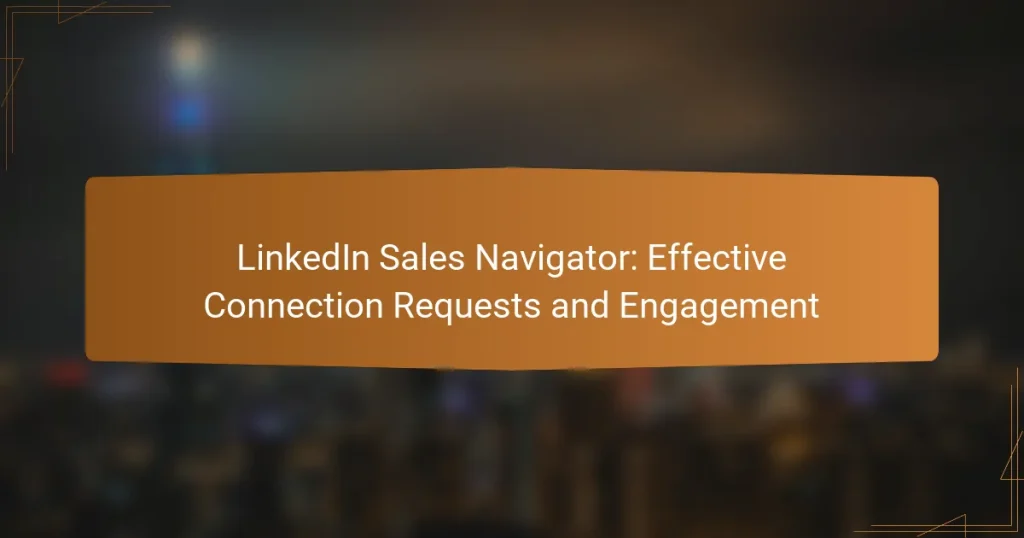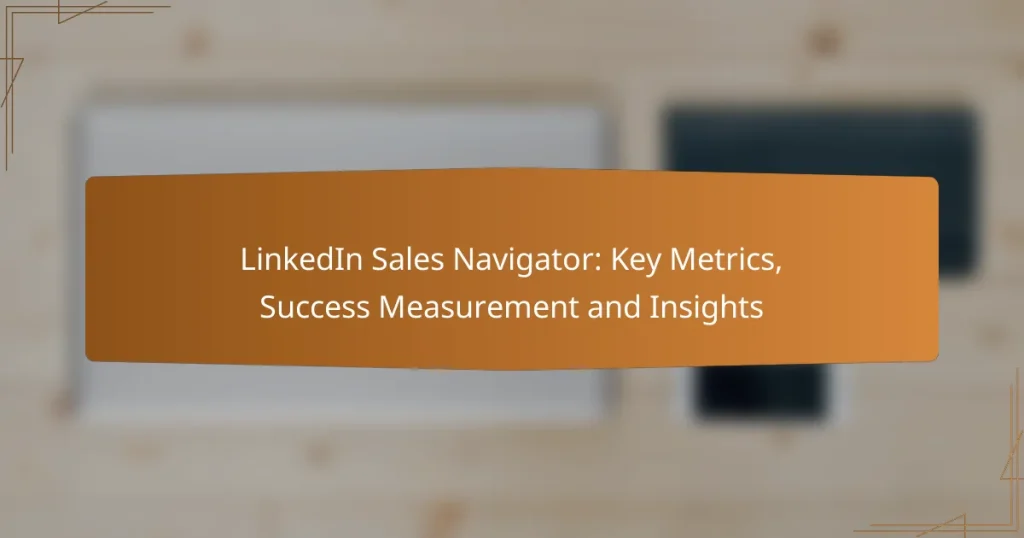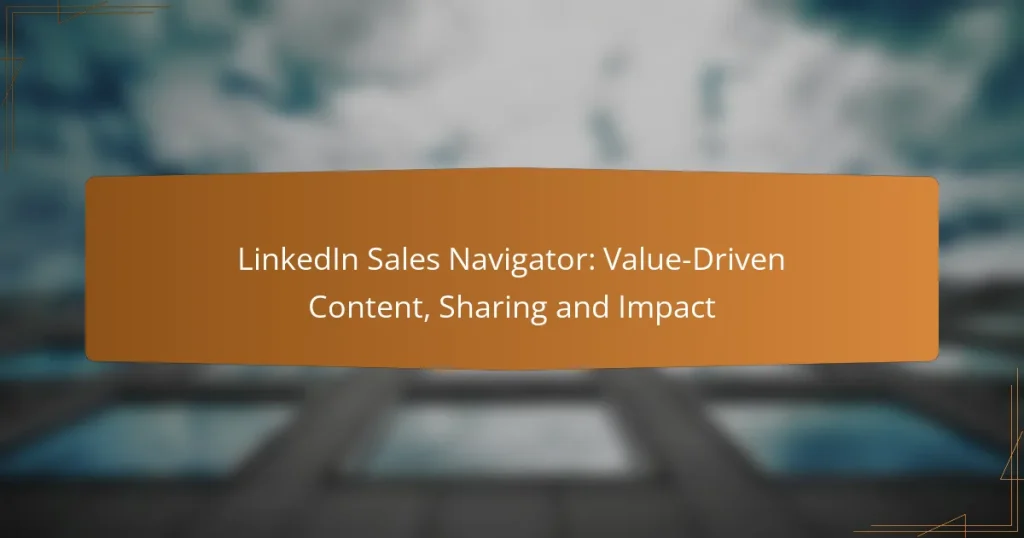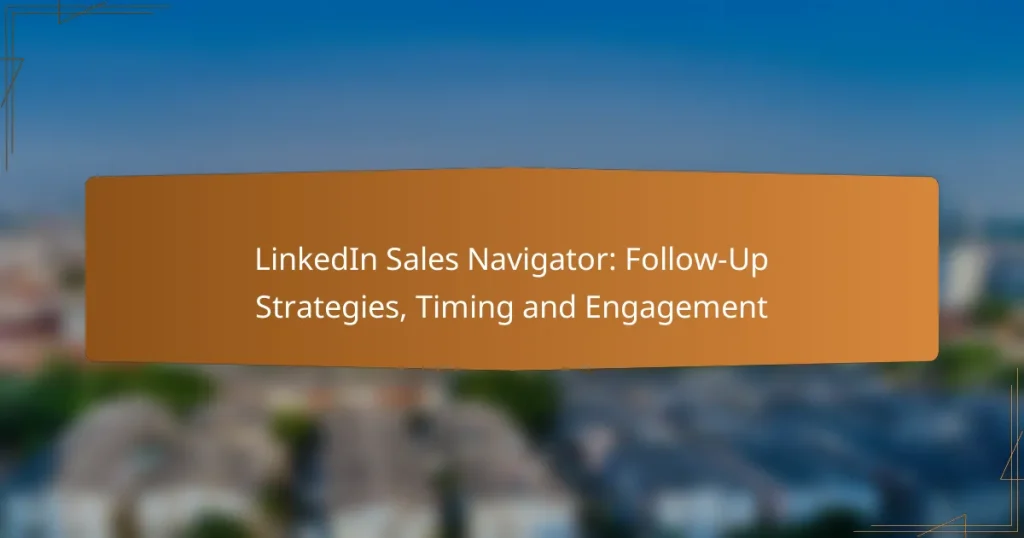LinkedIn Sales Navigator is an essential tool for sales professionals looking to enhance their lead generation efforts. With its advanced features such as lead recommendations and real-time insights, users can effectively connect with potential clients and improve their outreach strategies. By personalizing your approach and leveraging the platform’s capabilities, you can streamline your sales process and boost conversion rates.
LinkedIn Sales Navigator: Common Mistakes, Avoidance and Best Practices
LinkedIn Sales Navigator: Daily Routine, Consistency and Results
LinkedIn Sales Navigator: Personal Branding, Visibility and Trust
LinkedIn Sales Navigator: Key Metrics, Success Measurement and Insights
LinkedIn Sales Navigator: Value-Driven Content, Sharing and Impact
LinkedIn Sales Navigator: Follow-Up Strategies, Timing and Engagement
How to leverage LinkedIn Sales Navigator for lead generation?
LinkedIn Sales Navigator is a powerful tool for lead generation, allowing users to identify and connect with potential clients effectively. By utilizing its advanced features, sales professionals can streamline their outreach efforts and improve conversion rates.
Targeted lead searches
Targeted lead searches enable users to find prospects that match specific criteria, such as industry, company size, and job title. This precision helps in narrowing down the vast LinkedIn network to a manageable list of potential leads.
To conduct a targeted search, start by defining your ideal customer profile. Use keywords and filters to refine your results, ensuring you focus on leads that are most likely to convert.
Advanced filtering options
Advanced filtering options in Sales Navigator allow users to sort leads based on various parameters, including geography, seniority level, and company headcount. This feature enhances the ability to tailor outreach strategies to specific segments.
Utilize the ‘Lead Builder’ tool to combine multiple filters for a more refined search. For instance, targeting mid-sized companies in the tech sector located in Europe can yield high-quality leads.
InMail messaging strategies
InMail messaging is a key feature of Sales Navigator that allows users to reach out directly to prospects who are not in their network. Crafting compelling messages is crucial for engagement.
When using InMail, personalize your messages by mentioning mutual connections or specific interests. Aim for a concise and clear approach, ideally keeping your message under 200 words to maintain the recipient’s attention.
Account-based marketing integration
Integrating account-based marketing (ABM) strategies with LinkedIn Sales Navigator can significantly enhance lead generation efforts. ABM focuses on targeting specific accounts rather than a broad audience, making it essential to identify high-value prospects.
Utilize Sales Navigator to create account lists and monitor engagement. This allows for tailored content and outreach efforts that resonate with the needs of each account, increasing the likelihood of successful conversions.
What are the key features of LinkedIn Sales Navigator?
LinkedIn Sales Navigator offers several key features designed to enhance the sales process, including lead recommendations, real-time insights, and CRM integration capabilities. These tools help sales professionals identify potential clients, understand market trends, and streamline their workflow.
Lead recommendations
Lead recommendations in LinkedIn Sales Navigator utilize advanced algorithms to suggest potential clients based on your preferences and past interactions. This feature helps you discover new leads that align with your target audience, increasing the chances of successful outreach.
To make the most of lead recommendations, regularly update your preferences and criteria. This ensures that the suggestions remain relevant and tailored to your evolving sales strategy. Consider focusing on specific industries or job titles to refine your results further.
Real-time insights
Real-time insights provide valuable information about your leads and accounts, such as job changes, company news, and relevant updates. This feature allows you to engage with prospects at the right moment, enhancing your chances of making meaningful connections.
To leverage real-time insights effectively, set up alerts for key accounts and leads. This way, you can stay informed about significant developments and tailor your outreach accordingly. Engaging with prospects based on timely information can significantly improve your response rates.
CRM integration capabilities
LinkedIn Sales Navigator offers seamless integration with various Customer Relationship Management (CRM) systems, allowing you to sync lead and account information effortlessly. This integration helps maintain a unified view of your sales pipeline and enhances collaboration among team members.
When integrating Sales Navigator with your CRM, ensure that you regularly update both systems to reflect the latest information. This practice minimizes discrepancies and helps your sales team work more efficiently. Familiarize yourself with the specific integration options available for your CRM to maximize its benefits.
How to optimize LinkedIn Sales Navigator usage?
To optimize LinkedIn Sales Navigator usage, focus on personalizing your approach and leveraging its features effectively. This includes tailoring your profile, tracking engagement, and utilizing tags and notes to manage your leads efficiently.
Profile customization tips
Customizing your profile is crucial for making a strong impression on potential clients. Ensure your profile picture is professional and that your headline clearly states your value proposition. Include a compelling summary that highlights your expertise and the benefits you offer.
Additionally, showcase your accomplishments and endorsements to build credibility. Regularly update your profile to reflect any new skills or experiences, as this keeps your information relevant and engaging.
Engagement tracking methods
Tracking engagement is essential for understanding how your prospects interact with your content. Use Sales Navigator’s built-in tools to monitor profile views, connection requests, and message responses. This data helps you identify which leads are most interested in your offerings.
Consider setting up alerts for key activities, such as when a lead changes jobs or engages with your posts. This allows you to reach out at opportune moments, increasing the chances of a successful connection.
Utilizing tags and notes
Tags and notes are powerful features for organizing your leads and personalizing your outreach. Use tags to categorize prospects based on criteria like industry, engagement level, or sales stage. This makes it easier to filter and prioritize your follow-ups.
Notes can be used to record important details about each lead, such as previous conversations or specific interests. Regularly reviewing these notes ensures that your communication remains relevant and tailored to each prospect’s needs.
What are the best practices for messaging on LinkedIn Sales Navigator?
Effective messaging on LinkedIn Sales Navigator involves personalization, timely follow-ups, and strategic outreach. These practices enhance engagement and increase the likelihood of positive responses from potential clients.
Personalization techniques
Personalization is crucial for making your messages stand out. Start by researching the recipient’s profile to identify common interests or mutual connections, which can serve as conversation starters. Tailor your message to reflect their specific needs or challenges, using their name and referencing their work or achievements.
Utilize LinkedIn’s features to gather insights about your prospects. Mention relevant articles they’ve shared or comment on their recent posts to demonstrate genuine interest. This approach not only builds rapport but also shows that you value their expertise.
Follow-up strategies
Following up is essential, as many prospects may not respond to your initial message. Aim to send a follow-up message within a week if you haven’t received a reply. Keep it concise and friendly, reiterating your value proposition and inviting them to connect further.
Consider varying your follow-up approach. If your first message was formal, try a more casual tone in your follow-up. You can also share additional resources or insights that may interest them, reinforcing your position as a helpful contact rather than just a salesperson.
Timing for outreach
Timing plays a significant role in the effectiveness of your outreach. Research suggests that mid-week, particularly Tuesday to Thursday, tends to yield higher response rates. Avoid weekends and Mondays when professionals are often catching up on work.
Additionally, consider the time zone of your prospect. Sending messages during business hours in their local time can increase the chances of your message being seen promptly. Use tools that allow you to schedule messages for optimal times based on your recipient’s location.
How to measure success with LinkedIn Sales Navigator?
Measuring success with LinkedIn Sales Navigator involves tracking specific metrics that reflect your sales activities and outcomes. Key performance indicators (KPIs) and effective reporting tools are essential for understanding how well your strategies are working and where improvements can be made.
Key performance indicators
Key performance indicators for LinkedIn Sales Navigator include metrics such as connection requests sent, response rates, and the number of leads generated. Monitoring these KPIs helps you assess the effectiveness of your outreach efforts and refine your approach over time.
Another important KPI is the conversion rate, which measures how many leads turn into actual sales. A typical conversion rate for B2B sales can range from 1% to 5%, depending on the industry and the quality of the leads. Regularly reviewing these metrics allows you to identify trends and adjust your strategies accordingly.
Reporting tools
LinkedIn Sales Navigator provides built-in reporting tools that allow you to track your KPIs effectively. You can generate reports that show your engagement levels, lead activity, and overall performance over specific periods. Utilizing these tools can help you visualize your progress and make data-driven decisions.
In addition to LinkedIn’s native tools, consider integrating third-party CRM systems like Salesforce or HubSpot. These platforms can offer more comprehensive analytics and help you manage your leads more efficiently. Ensure that your chosen tools align with your sales goals and provide the insights you need to enhance your LinkedIn strategies.
What are common mistakes to avoid with LinkedIn Sales Navigator?
Common mistakes with LinkedIn Sales Navigator include failing to optimize your profile and neglecting to utilize analytics effectively. These oversights can limit your outreach potential and hinder your ability to track progress.
Neglecting profile optimization
Profile optimization is crucial for making a strong first impression on potential leads. Ensure your profile is complete with a professional photo, a compelling headline, and a well-crafted summary that highlights your expertise and value proposition.
Additionally, use relevant keywords throughout your profile to improve visibility in searches. This can help attract the right connections and increase engagement with your content.
Ignoring analytics
Analytics provide valuable insights into how your outreach efforts are performing. Regularly review metrics such as connection requests sent, response rates, and engagement levels to understand what strategies are working and where improvements are needed.
Set specific goals for your LinkedIn activities and use analytics to measure progress against these goals. Adjust your approach based on data trends to maximize your effectiveness on the platform.
How does LinkedIn Sales Navigator compare to other tools?
LinkedIn Sales Navigator stands out from other sales tools by offering advanced search capabilities, personalized recommendations, and integration with LinkedIn’s vast professional network. Unlike many CRM systems, it focuses specifically on lead generation and relationship building within the LinkedIn ecosystem.
Key Features of LinkedIn Sales Navigator
LinkedIn Sales Navigator includes features such as advanced lead and company searches, real-time insights on existing accounts, and personalized algorithm-driven recommendations. These tools help sales professionals identify and connect with potential clients more effectively than traditional methods.
Additionally, the platform allows users to save leads and accounts, receive updates on their activities, and utilize InMail messaging to reach out directly to prospects. This combination of features enhances the ability to build meaningful connections.
Pros and Cons of Using LinkedIn Sales Navigator
One of the main advantages of LinkedIn Sales Navigator is its extensive database of professionals, which provides access to a wide range of potential leads. The advanced search filters enable users to target specific industries, roles, and locations, making it easier to find the right contacts.
However, a notable downside is the cost, which can be significant for small businesses or individual users. Additionally, while it offers powerful tools, the effectiveness of the platform relies heavily on the user’s ability to engage and follow up with leads.
Best Practices for Maximizing LinkedIn Sales Navigator
To get the most out of LinkedIn Sales Navigator, start by clearly defining your target audience and utilizing the advanced search filters to narrow down your prospects. Regularly update your saved leads and accounts to stay informed about their activities and interests.
Engage with your leads by sharing relevant content and using InMail strategically to initiate conversations. Avoid generic messages; personalize your outreach to increase response rates. Lastly, track your interactions and adjust your approach based on what works best for your audience.






